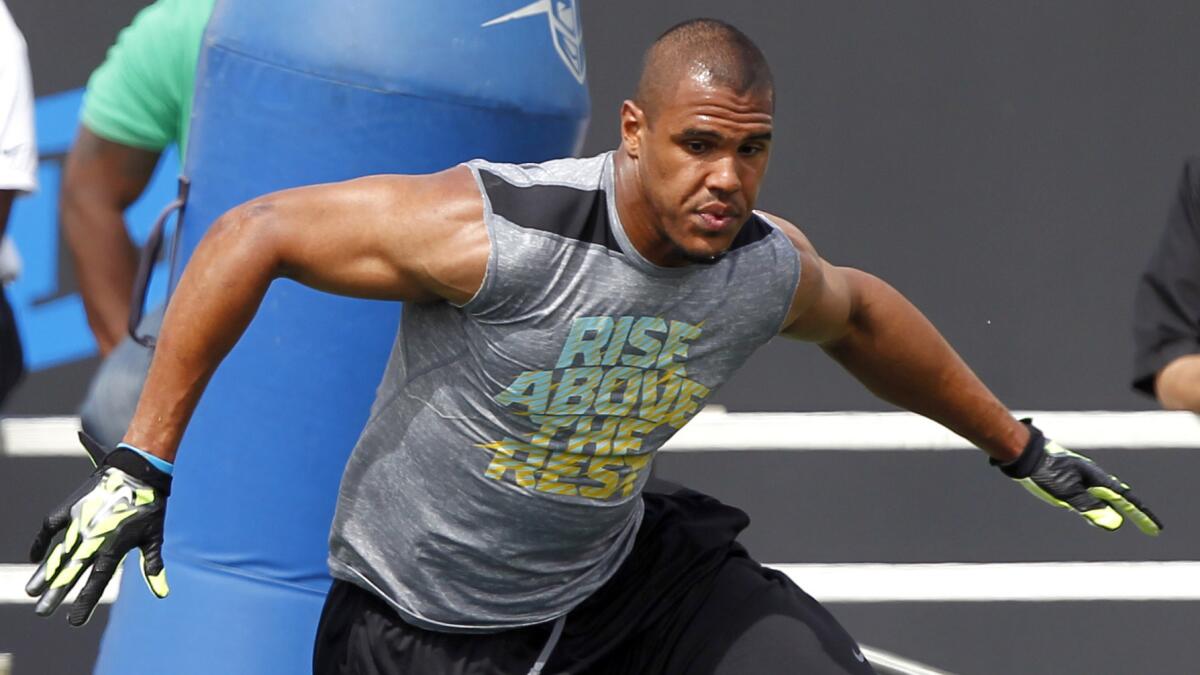UCLA’s Anthony Barr a mover and shaker on field, in NFL draft circles

- Share via
Anthony Barr has joined the jet-set crowd.
The former UCLA linebacker has been on a whirlwind tour of teams leading up to this week’s NFL draft.
So it goes when you are an All-American projected to be a first-round — maybe even a top-10 — pick.
It’s a radically different travel plan from the one he was on three years ago, when Barr had a one-way ticket to football oblivion.
One key change altered the itinerary. Before his junior season for the Bruins in 2012, Barr was moved from offense to defense.
The switch was not born of an epiphany. It just felt right — to Barr and to Jim Mora, who was just starting his first season as head coach. Former UCLA coach Rick Neuheisel, who recruited Barr out of Los Angeles Loyola High, also saw it. But he had committed to using Barr on offense.
What was immediately clear was Barr was built to be a linebacker — long, lean and powerful at 6 feet 5, 230 pounds. And instinctively disruptive.
The promise
Barr was a blue-chip college recruit despite sitting out his senior season at Loyola because of a broken ankle.
He was so highly regarded that USC joined the fray even though Barr’s family was rich in Notre Dame history. Tony Brooks, Barr’s father, played for the Fighting Irish, as had Reggie Brooks, an uncle.
Barr has said he “would have had to change my name or something” had he signed with the Trojans.
He had plenty of other choices.
Barr played safety for Loyola, but running the football is what he enjoyed most. He rushed for 1,890 yards and scored 20 touchdowns as a high school junior.
Neuheisel said he felt all along that Barr was a better fit for defense, but landing him as a UCLA recruit was the first order of business.
Barr wanted to be a running back and his mother, Lori, shared that vision. Tony Brooks gained 2,274 yards rushing for Notre Dame from 1987-91. Reggie Brooks ran for 1,372 yards in 1992.
“Lori said, ‘Promise me he will be a running back,’” Neuheisel recalled. “I was all too eager to say, ‘Yes.’ He had such a Notre Dame lean, I was thrilled I was making headway and might change his mind.”
Barr had speed, but his size was another big factor on offense in high school. That advantage disappeared in college. Opposing players matched Barr’s size and his rigid, straight-up running style made him an easy target. Teammate Dietrich Riley demonstrated that during training camp in 2010, flattening Barr with a vicious hit.
Barr’s career meandered even more when UCLA switched to the Pistol offense and he became the Bruins’ “F-back,” a tight end-fullback hybrid.
In two seasons, Barr had 54 yards rushing and caught 12 passes for 72 yards.
“He played the position he needed to play the last two years [at UCLA],” said Neuheisel, who was fired after the 2011 season. “As he got older, he knew that. I’m happy everything has worked out as well as it did.”
The switch
Mora arrived in December 2011 and he didn’t need to pore over tape to see that Barr was playing out of position. His eyes told him.
“I didn’t think he had a running back body,” Mora said.
Mora spent four seasons as an NFL head coach, 19 as an NFL assistant, and he knew what he was looking at.
“He had that linebacker body type,” Mora said. Former New Orleans Saints linebacker Pat Swilling, a five-time Pro Bowl selection, came to mind.
The Bruins were changing to a three-down-lineman, four-linebacker defense and Mora said, “we were looking for a guy that was athletic, who could hopefully use his length to affect the passer.”
Barr, who had beefed up to 250 pounds, was also seeking a change after two seasons of languishing on offense.
“I lost confidence in myself,” Barr said. “I kind of wavered. I really didn’t want to play the game anymore.”
No one remembers who broached the position change first.
“My version of events, it was an equal meeting of the minds,” Mora joked. “His version might be that he was thinking about it. Maybe I heard through the grapevine that he was maybe wanting to talk about moving to that position.”
The who and when matters little now. The move was the right one.
“It brought back my passion for playing,” Barr said.
That was clear the third day of his first training camp on defense. In the Bruins’ first 11-on-11 scrimmage, Barr disrupted the offense so dramatically that he was pulled off the field after three plays.
Afterward, a UCLA assistant coach jokingly asked a reporter not to write about Barr in order to keep him a secret.
But the secret was out.
Barr had 13.5 sacks in 2012, the most memorable a crushing hit that broke the collarbone of USC quarterback Matt Barkley. He had 10 sacks in 2013 and was a consensus All-American.
Next up: NFL riches.
More to Read
Go beyond the scoreboard
Get the latest on L.A.'s teams in the daily Sports Report newsletter.
You may occasionally receive promotional content from the Los Angeles Times.











